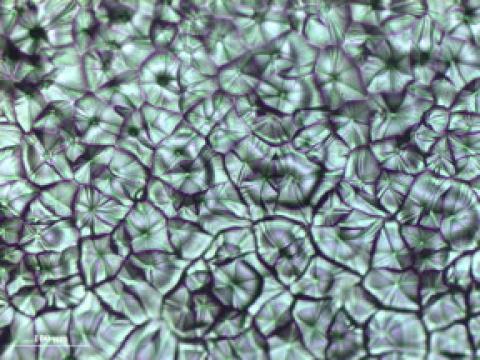Researchers at the Georgia Institute of Technology have demonstrated that a low-temperature solution printing technique allows fabrication of high-efficiency perovskite-based solar cells with large crystals for minimizing grain boundaries. The meniscus-assisted solution printing (MASP) technique reportedly boosts power conversion efficiencies to nearly 20% by controlling crystal size and orientation.

The MASP process uses parallel plates (approximately 300 microns apart) to create a meniscus of ink containing the metal halide perovskite precursors. The bottom plate moves continuously, allowing solvent to evaporate at the meniscus edge to form crystalline perovskite. As the crystals form, fresh ink is drawn into the meniscus using the same physical process that forms a coffee ring on an absorbent surface such as paper. It was stated that the process could be scaled up to rapidly generate large areas of dense crystalline film on a variety of substrates, including flexible polymers.
To establish the optimal rate for moving the plates, the distance between plates and the temperature applied to the lower plate, the researchers studied the growth of perovskite crystals during MASP. Using videos shot through an optical microscope to monitor the grains, they discovered that the crystals first grow at a quadratic rate, but slow to a linear rate when they began to impinge on their neighbors. "When the crystals run into their neighbors, that affects their growth," noted the researchers. "We found that all of the grains we studied followed similar growth dynamics and grew into a continuous film on the substrate."
The MASP process generates relatively large crystals - 20 to 80 microns in diameter - that cover the substrate surface. Having a dense structure with fewer crystals minimizes the gaps that can interrupt the current flow, and reduces the number of boundaries that can trap electrons and holes and allow them to recombine.
Using films produced with the MASP process, the researchers have built solar cells that have power conversion efficiencies averaging 18% - with some as high as 20%. The cells have been tested with more than 100 hours of operation without encapsulation.
Doctor-blading is one of the conventional perovskite fabrication techniques in which higher temperatures are used to evaporate the solvent. The researchers heated their substrate to only about 60 degrees Celsius, which would be potentially compatible with polymer substrate materials.
The researchers have thus far produced centimeter-scale samples, but they believe the process could be scaled up and applied to flexible substrates, potentially facilitating roll-to-roll continuous processing of the perovskite materials. That could help lower the cost of producing solar cells and other optoelectronic devices.
The team plans to fabricate the films on polymer substrates, and evaluate other unique properties (e.g., thermal and piezotronic) of the material.

